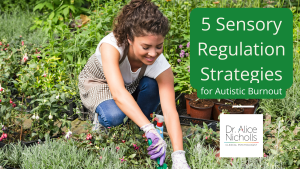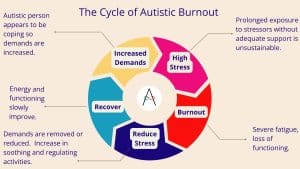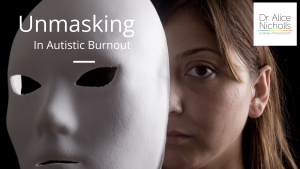We’ve covered What is Autistic Burnout? Am I in autistic burnout? And What Causes Autistic Burnout in previous posts.
So what do you do if you’re in autistic burnout? How do you recover?
This article will give you some ideas of how to start making your way out of autistic burnout. It might not be a fast journey, but with some changes to your lifestyle, expectations and support it is possible to feel better.
Please note that while this article is aimed at things you can do for yourself I want you to know that it is not your fault you have ended up feeling like this. Autistic burnout is an incredibly common experience within the autistic community. Our whole society is set up to favour neurotypical people’s needs and we have been socialised to think that we need to look and behave as neurotypical as possible. These things mean that we can be doing everything we think we should be doing and still burnout. Change is needed on a societal level, however, until then, here are some things that might help
1. Gauge how You are Feeling Right Now
It is really helpful to get some kind of measure for how bad things currently are for you. This will help you to know when things are getting better or if they are getting worse in the future. If 0 is the best you have ever felt and 10 is the worst you have ever felt then how bad do you feel on a scale of 0-10.
If you find it hard to gauge how bad things are it might help to use my Autistic Burnout Symptom checklist as a measure. Your score now can be compared to your future scores and give you a sense of whether things are better or worse.
It can also be helpful to write down some notes about how you know you are burnt out, what it feels like for you, what you would like to be different and how you would know if you felt better.
2. Identify the Sources of Stress in Your Life
Write down all the things that are making you feel stressed, these might be every day events like getting dressed in the mornings or making breakfast for the children. It might be that you are struggling more than usual with sensory sensitivitites- is the fan in the bathroom a problem? Or the kitchen lights? Is your house or workplace just too noisy? Is there a meeting at work that you dread every week? A What’s app group that won’t stop pinging? Are you feeling bothered by the need to remember every day task, like remembering to take the bins out, pick up bin liners from the corner shop or to respond to your emails. Are there big changes, life events, bereavement or trauma going on for you? Maybe you’ve been physically unwell, caring for a relative or grieving for someone you care about. Write or record everything down, even if it seems small or ridiculous.
My Clients often dismiss potential stressors saying that ‘that never used to be a problem’ about stressors. Bear in mind that stress can be cumulative, so while you might not have noticed a significant increase in stress previously, it could have been because your stress ‘baseline’ was much lower so you were more able to cope with minor stressors. When you are already highly stressed, any stressor, no matter how small can cause you to feel highly stressed.
If you can’t think of everything that causes you stress then start a list in a notebook or on an app on your phone/computer, when you notice something makes you feel worse write it down.
If you find it hard to know how you feel about anything then it might help to think about a time in your life when you didn’t feel so burnt out. What was different? Is there a friend or a relative that might recall a time when you seemed less burntout? Do they have any ideas what increases your stress levels?
It may help to read my article on What Causes Autistic Burnout to see if any of the causes resonate with you.
Common Causes of Stress for Autistic People:
- Whats app or messenger groups regularly notifying you of messages
- The pressure to respond to calls, emails, texts
- Masking – trying to appear neurotypical in your social interactions
- Masking- suppressing stimulations seeking behaviour
- The need to make small talk at the school gate, office, college or university
- Unmet sensory needs
- Overstimulation
- Aversive sensory stimulation (e.g. lighting, clothing, background noise)
- Unrealistic workload at work/ education/ home
- Working late pushes back evening routine
- Not enough time to do meal preparations so eating nothing or takeaways
- Changes in routine
- Unpredictable events
- Digestive problems
- Health problems
- Difficulty concentrating at work /college due to sensory or social demands
- Friends / Partner / Family wanting to talk or connect when you are too tired/ overwhelmed
- Social events that you are thinking about attending or have committed to attending
- Life events such as having a baby, the death of a loved one, getting married or divorced
- Having to remember to do something
- Daily hassles such as the car breaking down or not being able to get your favorite breakfast cereal
- Money
- Relationship problems
3. Take a Break Where You Can
I know this is easier said than done. You may find yourself thinking ‘there is no way I can take a break’, and honestly, if it was easy you would have probably already done it. Often when people get to the stage of realising they are in burn out they can feel too stuck to change anything.
Any amount of rest is likely to be helpful so even if you can’t take time off work/education/home responsibilities there are ways you can increase your rest time, even if it is just by a few minutes each day.
If you are financially able to take time off work, or have enough support in place to take time off other duties such as house work or childcare then seriously consider asking for a break. If you are burnt out and are in an employed position you may be able to take paid time off sick. If you are employed and get an annual leave allowance it might be a good idea to book some time of as soon as possible.
A break might be a few weeks off work on sick leave, taking a couple of days annual leave, asking your friend or partner to watch the children or do extra housework so you can take a few hours to yourself. It might just be taking a lunch break and going somewhere quiet where you can decompress.
If you look at the list of things that are causing you stress you will start to get an idea of what you need to take a break from. You may find you need to take time off work/education to recover. You might also find that you can get a bit more rest by scaling back, taking some occasional days off. You might find that there is a certain type of environment or person that you particularly need to take a break from.
Possible Ways of Taking a Break:
- Taking time off work/ education as sick
- Booking annual leave from work as soon as possible
- Asking to temporarily reduce your working hours (your GP may provide you with a certificate to say you need reduced hours)
- Asking for extensions on deadlines at work/ education
- Doing the bare minimum at work/in education/ at home
- Avoiding overtime or extra shifts/ projects
- Getting a cleaner or a childminder
- Asking your housemates/ partner/ family for time off from your usual responsibilities
- Going somewhere peaceful for your lunch break
- Leaving work on time
- Booking in a few hours each day/ week/ month where you have no demands on you at all.
I often see burnt out people prioritising staying at work and cutting back on all of the activities that bring them joy. While this might seem logical, it is counterproductive as people often end up having lower mood and energy from the lack of positive activities in their lives. If you have a little energy left then make sure you prioritise activities that bring you pleasure and give you a sense of achievement as this will help boost your mood.
4. Reduce Stress
If you look at the list of things that are causing you stress you will start to get an idea of what you need to change in your life.
Once you have your list, go through each item and work out how you could remove or reduce this stressor in the short, medium and/or long term.
Are any of the stressors easy to remove? It might help to look for the easy(ier) short term wins first. For example, you may be able reduce some sensory stressors by wearing ear plugs, cutting labels out of clothing or wearing sunglasses. There may be a relatively easy way of getting out of some of the social events you are feeling too tired to commit to. Take those easy wins first.
You might be feeling overwhelmed by lots of little jobs that are on your to-do list. Maybe some of these jobs could be put on hold, maybe some of them don’t really need doing. Ask yourself what would happen if you didn’t do those things? How bad would it be? This isn’t the time for perfectionism. Some things you might do in an ideal world but aren’t actually essential. For example, cooking from scratch, ironing and fixing non essential items.
For the ones that must be done it might help to write in your diary/ schedule on your calendar when you will do them.
Short Term Stress Reduction Ideas:
- Cancelling or postponing any plans that are not time critical
- Asking for extensions on deadlines
- Lowering standards regarding cooking- e.g. buying ready meals or recipe boxes
- Lowering standards regarding cleaning or outsourcing it
- Buying ear defenders/ earplugs/ noise reduction headphones
- Using one of 5 basic sensory regulation techniques
- Getting rid of or changing lighting that is bothering you
- Take a break from social media or group chats
Decreasing your stress in the short term will hopefully give you some space to rest and to think about what needs to change in the medium term. Going back to your list of stressors, what are the the things that are more difficult to fix? What is required? It might be that you have too much to do at work or that you don’t understand what you need to do to finish a job. At home you may be feeling overwhelmed by mess or by a lack of childcare. Maybe you know there are changes you could make to your environment that would help but you have not had the time or energy to make them.
Medium term stress reduction examples:
- Asking for reduced hours or responsibilities at work
- Asking to be moved to a less stressful job
- Finding a different job
- Developing a less stressful routine around housework
- Taking my short course on understanding and meeting your sensory needs
- Getting a sensory integration assessment and sensory diet designed to meet your sensory needs
- Re-negotiating or stepping down from responsibilities, at home, work, in voluntary or social roles
- Finding safe people, spaces and places where you feel less pressure to ‘mask’ and are able to engage in stimulation seeking behaviours as required.
- Read more about masking less here
- Consider taking my short course on masking less and connecting more
Medium term stress reduction techniques start to build a more sustainable life for you and will hopefully help you to continue to recover from burnout. As you recover you might find that you need to make more significant changes in your life.
Long Term Stress Reduction Examples:
- Decreasing contact with people with whom you feel you need to mask
- Developing confidence around expressing your needs for reasonable adjustments
- Prioritising friendships/ relationships where you feel safe and able to be your authentic self
- Engaging regularly with your special interests
- Making a sensory diet part of your daily routine
- Having a daily routine which is sustainable and allows space for unforeseen events
5) Increase Resources
So far this article has focused on identifying and managing sources of stress, but of course there are other ways of decreasing stress. While some activities, people and environments will drain your energy and increase your stress levels others will replenish your energy and decrease your stress levels. Spend some time writing a list of activities, people and environments where you feel replenished, or less stressed.
You may have a certain friend who always makes you feel better, a dog who will curl up on the sofa with you. You might feel connected to nature by taking a walk in the woods or swimming in the sea. You might just love being in a room in your house playing computer games, watching TV or reading.
If you struggle to write a list then start a list in your notebook or on a note app on your phone/ computer and write things down as you notice them over the next week. If you find it difficult to notice your emotions then it might be useful to ask yourself if you feel better or worse, okay or not okay during each activity and afterwards.
If you feel as if nothing in your life makes things feel better then you may still need more rest or might be experiencing depression instead or on top of your burnout. Once you have physically rested, try to gradually increase your engagement in your most recent, or one of your long term favourite, special interests, even if it is just for a few minutes a day. If you are feeling low in mood, it might take some time for this to improve. If you are concerned that you are depressed please visit your GP or healthcare provider for assessment and support.
6. Start to Design a More Sustainable Life
By the time you have completed steps 1-5 you should have a good idea of what you need in your life, what increases your stress levels and what decreases them. You may have identified some absolute non-negotiables that you need to work around (e.g. job, family etc).
Now it is time to work out what a reasonable level of energy expenditure is for you. By energy I don’t necessarily mean physical energy, this could be social, emotional or mental energy. Whichever you feel gets depleted when you are burning out. Try to think about your energy for your personal stressors in units such as ‘spoons of energy’ (see spoon theory article) or another unit such as ‘beans’ or ‘battery level %’’.
Imagine you start each day with a certain amount of energy and that this gets depleted by some activities and replenished by others. Start to record your activities each day and your energy levels at the beginning and end of each day. You will start to build a picture of how much energy each stressor takes away and how much you are left with at the end of the day. Over time you can work out how many stressors you can cope with before you are running ‘on empty’ or ‘in deficit’. Aim to end each day with a buffer of at least 20% for a sustained period of time and your burnout should eventually resolve. When you have managed to have a sustained period of ending each day with energy in the ‘bank’ you might find that you can increase your stress levels slightly, if you chose to do this then please make sure you continue to monitor your level of burnout and be prepared to scale back if you notice your burnout symptoms are returning.
You can read more about energy accounting here or take my short course on energy accounting here.
7. Let go of Shame
As an autistic individual growing up and living in a neurotypical world it is natural that you will have compared yourself to your neurotypical peers. Perhaps you have noticed them appearing to cope with a lot of the things that you find difficult. Maybe you have chastised yourself for struggling to do the things you can see ‘other people do everyday’. Just because neurotypical people cope (or appear to cope) with things you find unmanageable doesn’t mean you are less of a person. It also doesn’t mean you ‘should’ do all the things you think other people are doing. It also doesn’t mean you shouldn’t do the things you need to do, even if they seem odd to neurotypical people.
One of the biggest reasons I see people stay in burnout is because they continue to reach for unrealistic standards. It can be really hard to let go of those and it might help to speak with a therapist, friend, other autistic people or a peer support group such as Aupeer about the difficulty you have allowing yourself to meet your own needs and avoid burnout.
Conclusion
Autistic burnout is a natural reaction to living in a society that does not take account of our needs. It is not your fault and we need our employers, families, friends and society in general to understand that we have different sets of needs.
You can recover from burnout by understanding your own personal stress triggers, ways of lowering your stress levels and adapting your life so that your needs are met. Sometimes you might need help to get other people and/ or organisations to make reasonable adjustments for you. You might also need to let go of some high and/or neurotypical standards which are likely to be maintaining your burnout. This process can be hard and it can trigger feelings of shame. Please seek support and know that this is not your fault and you are not alone.
I specialise in working with people experiencing autistic burnout and I have written a blog series and online courses to help people recover from autistic burnout and live authentic, energised and inspired lives. For news of my latest posts and resources please follow me on Facebook or join my mailing list.











